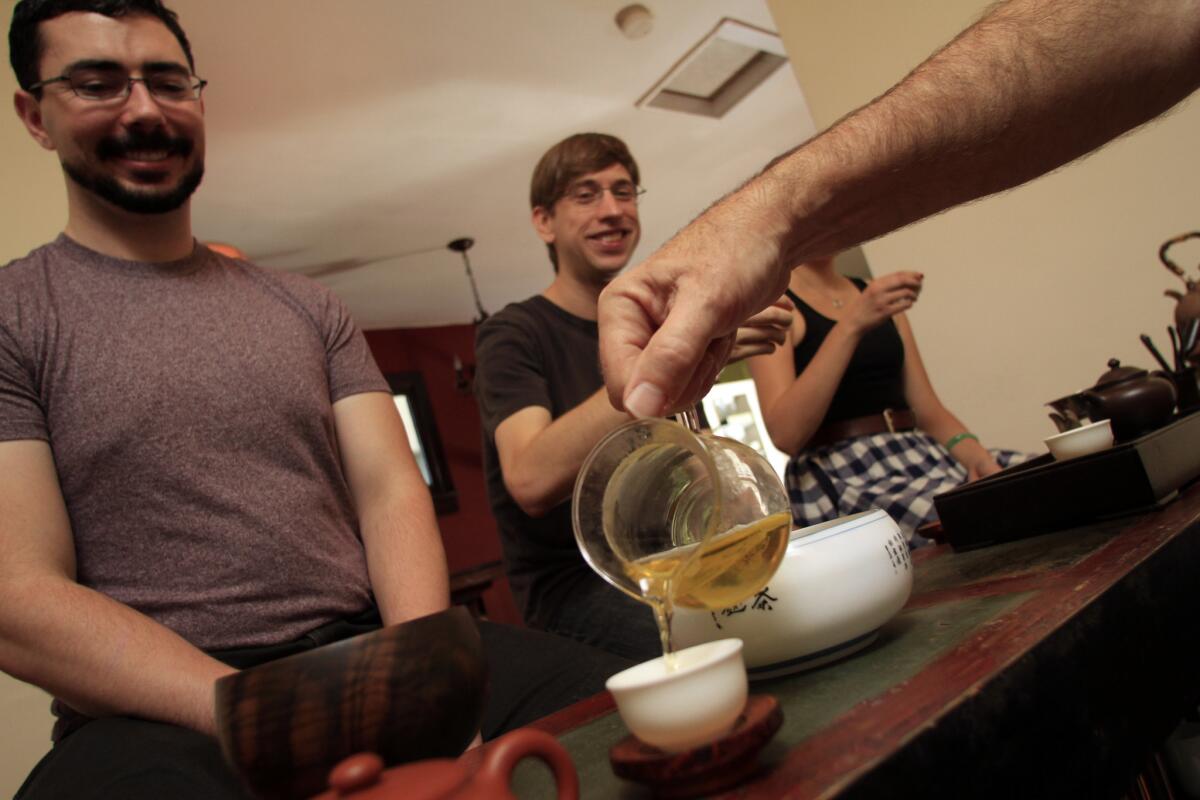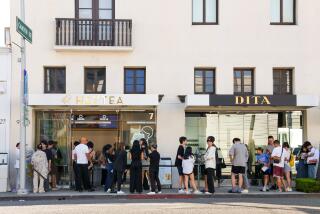Column One: Consumed by their passion for rare Chinese teas

In an Echo Park home, four friends gather around a fist-sized clay pot steaming with a rare vintage of puāer ā an aged tea from southern China whose most exotic variations sell for $1,500 a pound or more.
They delicately pour the amber brew into tiny tasting cups. Then, holding the porcelain cups with just two fingers, they take in the fragrance. Finally, they sip, gingerly.
The verdict is unanimous.
āItās kind of got that dirty bandage taste,ā Louise Yang says.
Her husband, Will Yardley, is more diplomatic. āItās a little sour,ā he concludes, adding that the taste would improve if they brewed the tea again.
So they do. After another measured ritual of pouring, smelling and tasting, they nod with satisfaction.
A region filled with wine, beer and coffee connoisseurs, Southern California also has a lesser-known culinary subculture centered on rare Chinese teas.
Aficionados will spend hundreds of dollars for a handful of rare tea leaves from remote mountains in China. They look for quality, for good vintage, for teas carefully stored and aged.
For generations, an elevated appreciation for tea was largely the domain of older Chinese immigrants who had grown up with fine teas. During the height of Chinese immigration into the San Gabriel Valley 20 years ago, the demand supported several high-end Chinese tea shops, including one run by the family of the oldest tea company in Taipei.
Now a new generation of connoisseurs of Chinese tea is emerging. For many, the fascination with tea comes not from growing up with it. Rather, they are newcomers to the culture of the leaf, learning about it as outsiders.
They seek teas with layers of sublime taste ā complexities lost on untrained drinkers. Brewing these teas is nothing like popping a tea bag into a cup of hot water. With rare Chinese teas, the key is looking for how the taste changes with each infusion. The first brew may be sharp, the second bitter, but this leads to the sweeter tastes of later rounds.
The teas are steeped in history, folklore and ritual. One tea tree in the Wuyi mountains is said to have been honored with the red robe of Chinaās emperor after its leaves cured the ruler of a deadly illness.
The new connoisseurs try to teach themselves about a culture they were not born into, learning Chinese and traveling to southern Chinaās ancient tea mountains, where they hunt for the best tea ware and perfectly aged puāer, some centuries old.
They have bonded online through blogs and chat rooms, reviewing vintages and debating the best water to use for specific teas.
āI have tried a local bottled water from Buxton,ā wrote one user on a TeaChat forum. āIt performs better than bottled French mineral waters, but my local tap water with the Chlorine and Fluorine removed by Britaā¦ gives me great results.ā
Yardley, 34, prefers Volvic water.
The Caltech software administrator discovered through trial and error that the French spring water makes some medium-roast teas taste better.
Yardleyās tea obsession took hold when he started dating Louise Yang and noticed that her family drank loose-leaf tea. Curious, he searched online, devoured books and discovered the history of high-grade tea and the scientific precision involved in brewing it. He lost interest in collecting bikes and in his thousands of vinyl records, and turned his attention to tea.
In his San Gabriel home, a humidity-controlled cigar cabinet stores his naturally aged puāer, and stacks of plastic bins hold his oolong and rock teas. An Excel spreadsheet helps him keep track of the varietiesā ages.
He dug through his shelves of clay teapots and porcelain gaiwans, deciding on the perfect pot to use for the medium-roast Fujian tea he wanted to drink on a recent afternoon.
He packed 10 grams into a clay teapot smaller than his fist. The rare tea is a luxury that can cost $130 for just 25 grams. Called a ārock teaā in Chinese, the variety has a distinct taste because of the way itās grown in the cracks of Fujian provinceās steep cliffs. Holding the glass kettle exactly six inches above the teapot, he poured slowly, taking care not to burn the tea.
After a few more steps ā rinsing out the first brew, sifting the tea leaves with a small bamboo pick and brewing a second infusion ā the tea was ready. He finished his tiny cup in three sips and nodded approvingly.
Yardley spent years practicing how to brew gongfu-style, a method that requires precise heat and perfect timing. Unlike single-use tea bags, gongfu-brewed teas can have up to 20 unique infusions, depending on the quality of tea leaf and technique of the brewer.
Full appreciation of a tea requires at least a dedicated half-hour of tasting. Sampling more than one tea would require an entire afternoon.
But how many people today have the stamina to brew out an oolongās floral aftertaste, or drink through the 14th brew of a puāer to analyze the tastes in each infusion?
āMy in-laws think itās a bit silly,ā Yardley said, chuckling. āEven Louiseās grandfather would drink only one or two infusions of a really good tea and just throw it out.ā
So Yardley often drinks alone, his notebook his only companion. He jots down adjectives to describe the flavors and aromas. Even at work, he adds notes to an unending text document that he started three years ago.
Some recent entries included descriptions such as:
Surprisingly sweet
Leaves seem medium roast
Nice fragrance when brewed in a small pot
āI tend to focus on things I wouldnāt remember or things that strike me about the tea,ā he said.
His obsession has connected him to other tea aficionados, who, like him, have traveled to the Far East to learn more about the teas they love.
Jason Fasi, 28, got hooked a few years ago when he strolled into a Chinatown shop with a huge selection of Chinese tea.
āIt was like walking into a secret library,ā he recalled.
Heās traveled to China three times, visiting tea factories, trying new food and learning about the culture. He picked up enough Chinese to talk shop with tea vendors.
āWhen I walked into a tea shop in Xiāan and asked for puāer,ā Fasi recalled, āthe tea shop owner told me: āPuāer is for old men or young women. So, which one are you?ā ā
Puāer has become his favorite tea. Originally offered as tribute to emperors, the rare tea still symbolizes luxury and status in China. According to legend, puāer dates back 4,700 years. Some of the tea trees are as old as 1,700 years. There are also cheaper varieties that āimitateā the naturally aged taste of expensive vintages.
Fasiās Honda Civic bears the personalized license plate ā<3 PUERH,ā and heās fond of referring to puāer as āthe scotch of teas.ā
Because its taste improves with age, puāer is considered a ādrinkable antique.ā Raw puāer from the 1950s to ā70s can command as much as $20,000 a pound, depending on its vintage and method of storage.
Die-hard collectors buy young puāer teas and wait for them to age. āWith a cake of puāer, you are buying it believing that itās going to become something,ā Fasi said. āItās almost like the aspirations you would have for a child.ā
Fasi writes a popular puāer blog. He and fellow bloggers organized what became a monthly gongfu tea club. Fasi recently moved from West Hollywood to Atlanta but still attends club meetings when heās back in Los Angeles.
The two dozen or so members arenāt even sure of the name of the club; they just call each other tea friends.
āIs the water too hot?ā asked Yardley, brewing a puāer at a recent gathering.
Linda Louie, a puāer specialist and online vendor, assured him the temperature was fine.
A retired L.A. County court administrator, Louie dropped her coffee habits, found a renowned tea master in Hong Kong and returns to China at least once a year to continue her tea studies. She proudly shared with the group a sample of the oolong she had made using knowledge gained on a recent trip to Taiwan.
āIt was hard work,ā she told the group, as she rinsed the leaves with hot water. āWe were sweating because we had to roll the leaves into balls ā squeeze it hard enough for juices to come out so it sticks. We were up until 1 a.m.ā
The group declared the brewing a success.
Back at the Echo Park home, owned by a tea club member, the group assembled in a space next to the dining room decorated with Asian paintings and tea ware. The owner calls it his tea room.
Yardley was busy finishing the eighth infusion of a 2004 puāer. He sat at the tea table ā made from a refurbished opium bed ā and paused, deep in thought.
āItās got that taste like bread mold that Iāve never been able to describe,ā he said, āthe burned onion on the bottom of a bagel taste.ā He finished his cup and started fiddling with the other teas Fasi had brought.
āOK,ā Yardley said, āwhat should we try next?ā
Twitter: @RosannaXia
More to Read
Sign up for Essential California
The most important California stories and recommendations in your inbox every morning.
You may occasionally receive promotional content from the Los Angeles Times.











